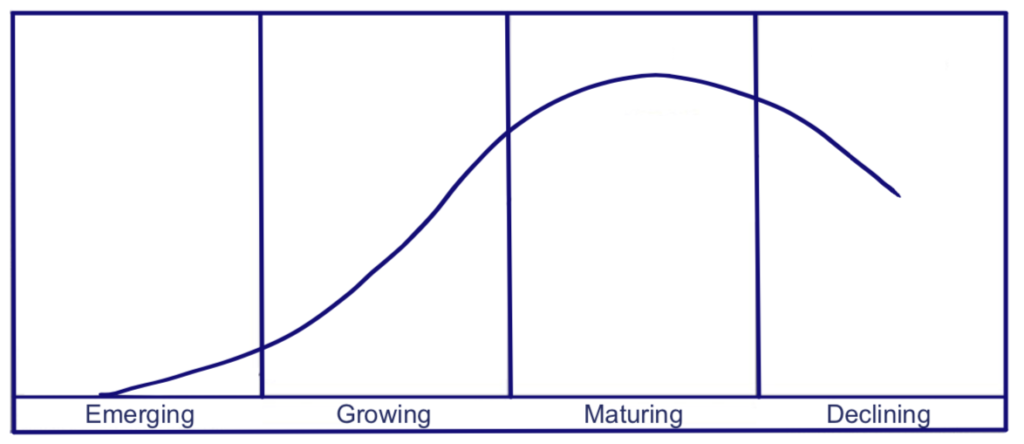The Focus Challenge – Part I: Your Practice

1. Substantive Practice
Gone are the days when some level of specialization in an area could sustain a practice over a lawyer’s lifetime. Things are changing too fast and new competitors will emerge – some of them not even law firms.
In the meantime, what you can do is think about the future of both your practice area and the clients you serve.
We’ve been using this life cycle S-curve for a long time. It was borrowed from industry and the legal profession has embraced it gradually over the last number of decades. The graph applies to both your substantive practice, and the client you serve within it.

The S-curve may be applied to your practice, your firm, your practice area, your client, an industry, or all of the above. Most work gravitates to the right side of the curve where rates are low and competition is high, as opposed to the left where exciting emerging areas afford major strategic opportunities with few competitors and low resistance to fees. Therefore, it is necessary to be forward-thinking.
2. The Business of Law in a Digital World
I am asked by people at international associations of law firms, and sometimes by those at individual firms, “How is the practice of law changing? What do I need to know, and how do I keep up?”
The oldest members of your firm might remember when firms began to use computers for data-processing. All lawyers will remember the accelerating change of technology — from how word-processing is done to how documents are generated.
Today, with machine learning and what is commonly referenced as “artificial intelligence,“ the quality of documentation is ever-enhanced, while the cost of generating it decreases.
Many firms seem unaware that they now exist in a digital environment that needs to be nurtured. Firms are now rated on-line whether they like it or not, and enlightened firms are fostering more positive reviews.
This is not the place for a deep dive on the subject, but it is a caution that firms that are not making a considerable effort to learn the changing technology around them – and to embrace it – will soon be left behind.
3. The Firm
Well-managed firms outcompete poorly managed firms. Firms with a business plan outcompete firms without a business plan. Why then, at conferences where managing partners gather, do we see by the use of anonymous voting machines that the vast majority of firms don’t have a business plan? (I’m referring to a sample across a wide spectrum of firm sizes. If you’re thinking that the top 25 firms in the world likely have a plan, you are correct.) Firms that do not see the benefit of managing the business of law are being left behind.
The better firms train their leaders on how to get improved performance from their people. The better firms train their individual lawyers on client-relations skills so they can give greater satisfaction to their clients and attract more desirable work, both in traditional ways (via personal relationships) and in digital ones (through an online presence).
I’d be happy to discuss any of the component pieces of this article in greater depth as a courtesy to my readers. Contact me at edge.ai or at my blog, gerryriskin.com.
In the next two parts of this series of articles, I will be touching on:




